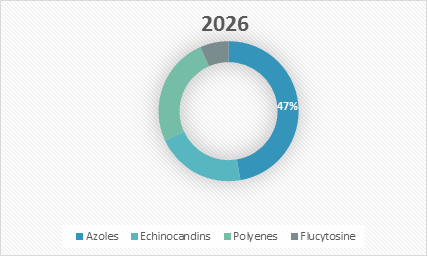Candidiasis Market – Market Insights
Candidiasis is a type of infection caused due to the yeast – candida, also classified as fungus, which is present in the human body. It is usually present in places such as mouth, belly, and on the skin. This dormant yeast can lead to candida infection at any stage in a person’s life and is closely linked to the immunity level of the person. There are various types of infections caused due to candidiasis such as thrush/ oropharyngeal candidiasis, genital yeast infection/ invasive infection, and cutaneous candidiasis.
The global candidiasis market size was valued at US$ 873.8 million in 2017, and is expected to exhibit a CAGR of 4.6% over the forecast period (2018–2026).
Figure 1. Global Candidiasis Market Value (US$ Mn), by Region, 2018

To learn more about this report, Download Free Sample
Source: Coherent Market Insights Analysis (2019)
Increasing incidence of invasive candidiasis and vaginal candidiasis to propel the global candidiasis market growth
Increasing number of invasive candidiasis and vaginal candidiasis cases and preterm births imposes high economic burden on the patient-population, thereby augment the global candidiasis market growth. For instance, according to the Centers for Disease Control and Prevention (CDC), 2017, candidemia, a form of invasive candidiasis, was one of the most common bloodstream infections in the U.S., with an average incidence of around 9 per 100,000 cases between 2013 and 2017.Moreover, according to the same source, 2017, around 84% of the total healthcare cost and 48% of the hospitalizations for Candida infections were due to invasive candidiasis, where the average cost per hospitalization for invasive candidiasis was around US$ 64,723- US$ 153,090.
Health complications associated with candidiasis during and after pregnancy are also expected to augment the market growth. For instance, according to the CDC, in 2015, vaginal candidiasis was the second most common type of vaginal infection after bacterial vaginal infection. The CDC estimates that around 1.4 million outpatient visits for vaginal candidiasis occur annually in the U.S.
Increasing number of preterm births is expected to boost the market growth. For instance, according to the Kolling Institute of Medical Research, 2015, vaginal candidiasis can increase the risk of preterm births. Moreover, according to a survey by researchers from the University of Miyazaki in 2017, the incidence of vulvovaginal candidiasis (VC) during pregnancy is around 13–20% globally. Furthermore, according to the Obstetric and Gynecology Department, Italy, 2018, VC is estimated to be the second most common cause of vaginitis and is found in 40% of women with vaginal discomfort. VC can cause systemic infections in premature neonates, particularly those with low birth weight.
However, increasing adoption of alternative therapies, which include over-the-counter treatments, boric acid capsules, and herbal treatments such as tea tree oil, probiotic supplements, and enteric-coated essential oils, for treatment of candidiasis, is expected to hinder the market growth.
Figure 2. Global Candidiasis Market Share (%), by Drug Class

To learn more about this report, Download Free Sample
Source: Coherent Market Insights Analysis (2019)
Increasing research and development of novel treatments to bolster the market growth
The market is expected to register significant growth as various research institutes are focused on developing novel drug combinations to enhance drug efficacy. For instance, in June 2019, microbiologists at the Beth Israel Deaconess Medical Center (BIDMC) demonstrated that combination of anti-fungal and anti-bacterial medications can effectively target multidrug resistant Candida auris. Similarly in October 2018, researchers at the American Society for Microbiology identified a compound alexidine dihydrochloride, which has the highest antifungal and anti-biofilm activity against a diverse range of fungal pathogens, thus having a greater potential for use as a pan-antifungal drug.
Key Players
Major players operating in the global candidiasis market include, Basilea Pharmaceutica Ltd., Astellas Pharma Inc., Grupo Ferrer Internacional, S.A., Pacgen Life Science Corporation, NovaDigm Therapeutics, Inc., Cidara Therapeutics, Inc., Amplyx Pharmaceuticals Inc., and Pfizer, Inc.
Key Developments
Major institutes and universities are focused on R&D activities related to candidiasis. For instance, on September 09, 2019, a team of researchers from Southmead Hospital, Bristol, in collaboration with Triticum Exploitatie B.V., tested the vulnerability of Candida albicans to honey and an MGH formulation (L-Mesitran) by evaluating five isolates from vaginal samples of symptomatic patients suffering from recurrent vulvovaginal candidiasis.
In August 2019, researchers from Complutense University of Madrid developed fast-dissolving orodispersible films of amphotericin B for oropharyngeal candidiasis.
In July 2019, researchers from Instituto de Química Rosario, Argentina, designed chitosan nanoformulations for the delivery of antifungal agents. The approach can aid in the development of a pharmaceutical dosage form suitable for the treatment of vaginal candidiasis.
Share
Share
Missing comfort of reading report in your local language? Find your preferred language :
Transform your Strategy with Exclusive Trending Reports :
Frequently Asked Questions
Select a License Type
Joining thousands of companies around the world committed to making the Excellent Business Solutions.
View All Our Clients